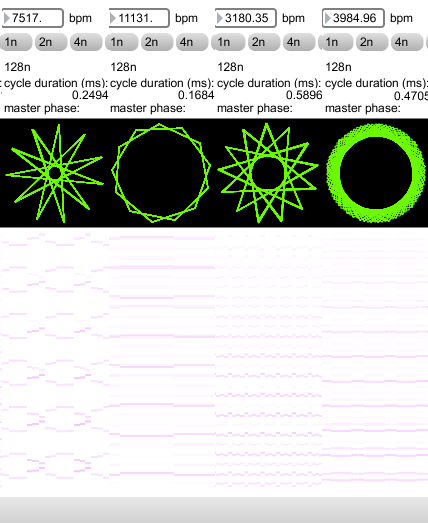5.4 Aesthetic analogies in the exploration of CirSeq patterns
The idea of a domain dichotomy – contrasting time- and frequency-domains when we think about aspects of sound – has been discussed in connection to saw~onepole~noise~click~. That discussion, at §3.6.1, illustrates how each of the concepts listed in the title of that composition can be thought of in terms of each domain. Exploration of CirSeq Zero has delivered clear demonstration that those two domains are but different parts of a single thing, which, in the historical contextualisation at §(5.3.3.f), is described as a concept of unity.
One way to comprehend this unity is to think of the property of duration as being common to both domain perspectives. The spiroid-frequency-space is an otherwise atemporal model for visual representation of duration; the CirSeq time-space is a visual representation of (harmonically quantised) sub-divisions of a given duration. Through the creation of, and extended experimentation with, CirSeq Zero I have gained experiential appreciation of one method for navigating the continuum between the two domains.
5.4.1 Exploration of the continuum – further detail
The example of a CirSeq pattern in which a single node is given amplitude has been described in §(5.3.4.c). In that pattern, a fixed-frequency sinusoid is heard for an eighth of the time-space duration; this is heard as the repetition of a simple 'beep'. As the momentum of angular traversal in the time-space is increased into the audible frequency range, the positional identity of the node as a sub-division of time becomes lost. The time-domain-like repetition of a beep soon becomes a continuous tone, and as rate of traversal in the CirSeq pattern increases further, the positional identity of the node's audible contents is gradually degraded in the frequency-domain as well. When extreme tempi are employed, the audio output is as much to do with DSP aliasing as it is with the CirSeq pattern being played, and the things that are are found in that sound are far more rich than its humble specification may have suggested.
While experimenting with extreme tempi, to produce the meta-patch example described above, I chose to focus on finding geometrical shapes in the visual aliasing of the master phase display. Because of this choice, a most intriguing discovery was made that again calls to mind the concept of layers of abstraction, as well as notions of circularity:
The four aliasing examples that are shown at the right of Figure 5.24 – starting from the second eleven-pointed star – are reproduced in Figure 5.25 to show better the sonogram details. Manifest in the audio output at these tempi are short looping melodic pattens, akin to those that CirSeq can produce at more regular tempi, but remember that these examples are all of the same one-eighth-node CirSeq pattern.

Figure 5.25: 4of_the_phase_shapes
At 7517 bpm (as in the left-most example in Figure 5.25), the cycle duration is equivalent to slightly less than eleven samples, and the interaction of that rate and the specified (one node) CirSeq pattern produces a repetitive pattern of multiple pitches. It is almost as if the continuum, that exists between the pitch-rhythmic time-domain level of perception and the spectral-timbre frequency-domain level of perception, has been followed so far along that – having gone through and beyond the frequency-domain range – its manifestation has reemerged as pitch-rhythmic.
At the risk of again invoking the chroma paradox – and to cite a contemporary cultural meme that I had not expected to feature in my research: the Double Rainbow viral video (Yosemitebear62, 2010; Anon, 2013) – the analogy of a double rainbow is suggested for this reemergence of properties thought to belong lower in the continuum, and with it the question: what does it mean?
Despite the irony of doing so, that analogy of refracted light will be extended just a little further in connection to the experimental exploration continua.
5.4.2 Observation of a specific configuration
For sunlight to refract through crystal glass in such a way as to project a rainbow on a given surface, there are many physical conditions (such as relating to various angles of orientation, and intensity of the sunlight) that must be met. Similarly, the specific examples of geometrical shapes, and the unexpected instances of time-varying spectra exposed in the given examples with CirSeq Zero and its meta-patch, are manifest only through particular conditions of the software configuration (DSP sampling rate, affecting both audio and visual outputs, and buffer setting in scope~ being particular for the visualisations that were a focus of the exploration).[n5.12]
[n5.12] In different experiments I have found that the DSP vector size settings affect the audio output, but this seem not to be the case for this example.
If the tempo values exemplified in this meta-patch were to used while the DSP sampling were set to a rate other than 44100, then interesting things would still be heard, but – because of the different aliasing – they would not be the same things for which the meta-patch was designed. One may expect there to be other tempo values that would be found to give rise to similar aliasing 'artefacts' at different sampling rates.
While keeping the recommended sampling rate for the tempi available through the CirSeqZero_example_of_control.maxpat meta-patch, it is also stimulating to specify a CirSeq pattern that is rather more complex than the single node discussed so far. With arbitrary CirSeq patterns active in CirSeq Zero, there are numerously more time-varying patterns to be heard, as well as a multitude of richly complex spectra that could prove fertile ground for further research.